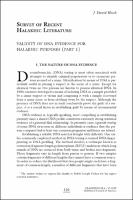Please use this identifier to cite or link to this item:
https://hdl.handle.net/20.500.12202/10027| Title: | Validity of DNA evidence for purposes of Halakhah (part 1) |
| Authors: | Bleich, J. David Rabbi Joseph Cohen |
| Keywords: | Deoxyribonucleic (DNA) testing crime identification establishment of paternity paternal-filial relationship |
| Issue Date: | 2019 |
| Publisher: | Rabbinical Council of America (RCA) |
| Citation: | Bleich, J. D. (2019). Validity of DNA evidence for purposes of Halakhah (part 1). Tradition, 51(4), 120-172. |
| Series/Report no.: | Tradition: A Journal of Orthodox Jewish Thought;51(4) |
| Abstract: | Deoxyribonucleic (DNA) testing is most often associated with attempts to identify criminal perpetrators or to exonerate persons accused of a crime. Identification by means of DNA is particularly useful in placing a suspect at the scene of a crime. Except for identical twins no two persons are known to possess identical DNA. In 1984 scientists developed a means of isolating DNA in a sample provided by a crime suspect or victim and comparing it with a sample recovered from a crime scene or from clothing worn by the suspect. Although the presence of DNA does not in itself conclusively prove the guilt of a suspect, it is a crucial factor in establishing guilt by means of circumstantial evidence. •DNA evidence is, logically speaking, most compelling in establishing paternity since a shared DNA profile constitutes extremely strong statistical evidence of a paternal-filial relationship. In paternity cases, a partial overlap of some DNA structures in different individuals is evidence that the persons compared had at least one common progenitor and hence are related |
| Description: | Scholarly article / Open access |
| URI: | https://traditiononline.org/survey-of-recent-halakhic-literature/ https://hdl.handle.net/20.500.12202/10027 |
| ISSN: | 0041-0608; 2768-023 |
| Appears in Collections: | Benjamin N. Cardozo School of Law: Faculty Publications |
Files in This Item:
| File | Description | Size | Format | |
|---|---|---|---|---|
| Bleich-1 2019 OA Validity.pdf | 410.42 kB | Adobe PDF |  View/Open |
This item is licensed under a Creative Commons License

